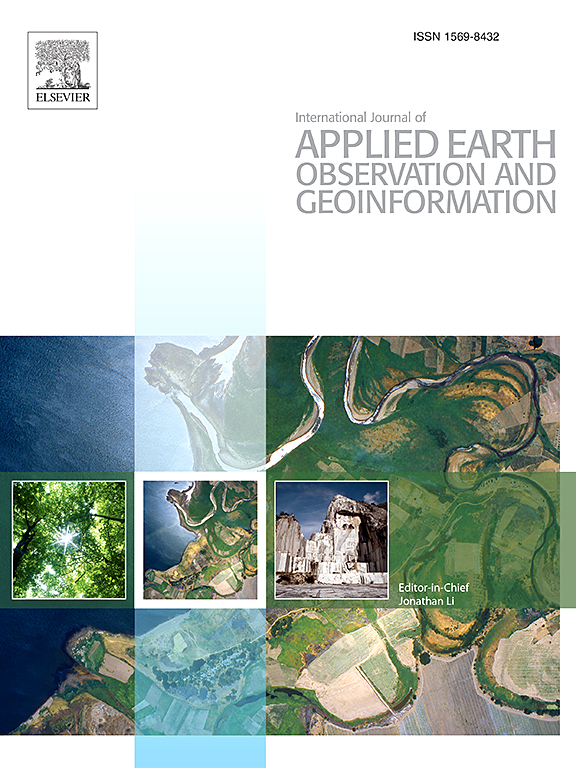RoofMapNet: Utilizing geometric primitives for depicting planar building roof structure from high-resolution remote sensing imagery
IF 7.6
Q1 REMOTE SENSING
International journal of applied earth observation and geoinformation : ITC journal
Pub Date : 2025-06-11
DOI:10.1016/j.jag.2025.104630
引用次数: 0
Abstract
The accurate extraction of building roof structures from aerial imagery represents a fundamental task for urban digital twin systems, facilitating critical applications such as 3D city modeling and solar potential assessment. Despite recent advancements in geospatial artificial intelligence, existing methods frequently encounter challenges posed by real-world complexities. These include structural heterogeneity caused by diverse architectural styles, discontinuities in roof structures due to occlusions from vegetation and other obstacles, and the limited generalization ability of models stemming from the scarcity of specialized annotated datasets. In this paper, we introduce an end-to-end network called RoofMapNet, specifically designed for extracting roof structures. First, we propose a strategy for roof junction extraction that integrates dynamic Gaussian heatmaps with quadratic coordinate calibration. This strategy enhances the model’s robustness in junction prediction under heterogeneous sample distribution scenarios. To address the loss or blurring of roof lines caused by occlusion and shadow, we propose an adaptive occlusion-aware module. This module employs a bidirectional mapping between geometric and feature spaces to refine candidate lines accurately, thus improving the model’s generalization ability and robustness in roof line detection. Additionally, to comprehensively evaluate the performance of roof structure detection models, we meticulously annotated a diverse, large-scale remote sensing imagery dataset for roof structure extraction, named RoofMapSet. Comprehensive evaluations on the VWB and RoofMapSet datasets demonstrate state-of-the-art performance, with mean improvements of 4.13% and 2.85% over competitors, respectively. Further analyses confirm the resilience to varying spatial resolutions and complex occlusion patterns. Our code and data are available at: https://github.com/CVEO/RoofMapNet.
屋顶地图网:利用几何基元从高分辨率遥感图像中描绘平面建筑屋顶结构
从航空图像中准确提取建筑屋顶结构是城市数字孪生系统的一项基本任务,有助于3D城市建模和太阳能潜力评估等关键应用。尽管地理空间人工智能最近取得了进展,但现有方法经常遇到现实世界复杂性带来的挑战。其中包括不同建筑风格导致的结构异质性,植被遮挡和其他障碍物导致的屋顶结构不连续性,以及由于缺乏专门注释数据集而导致的模型泛化能力有限。在本文中,我们介绍了一个名为RoofMapNet的端到端网络,专门用于提取屋顶结构。首先,我们提出了一种将动态高斯热图与二次坐标校准相结合的屋顶结点提取策略。该策略增强了模型在异质样本分布场景下的结预测鲁棒性。为了解决遮挡和阴影导致的屋顶线条丢失或模糊问题,我们提出了一个自适应遮挡感知模块。该模块采用几何空间与特征空间的双向映射,精确地细化候选线,从而提高了模型在屋顶线检测中的泛化能力和鲁棒性。此外,为了全面评估屋顶结构检测模型的性能,我们精心注释了一个用于屋顶结构提取的多样化、大规模遥感图像数据集,名为RoofMapSet。对VWB和RoofMapSet数据集的综合评估显示了最先进的性能,平均sAP分别比竞争对手提高了4.13%和2.85%。进一步的分析证实了对不同空间分辨率和复杂遮挡模式的弹性。我们的代码和数据可在:https://github.com/CVEO/RoofMapNet。
本文章由计算机程序翻译,如有差异,请以英文原文为准。
求助全文
约1分钟内获得全文
求助全文
来源期刊

International journal of applied earth observation and geoinformation : ITC journal
Global and Planetary Change, Management, Monitoring, Policy and Law, Earth-Surface Processes, Computers in Earth Sciences
CiteScore
12.00
自引率
0.00%
发文量
0
审稿时长
77 days
期刊介绍:
The International Journal of Applied Earth Observation and Geoinformation publishes original papers that utilize earth observation data for natural resource and environmental inventory and management. These data primarily originate from remote sensing platforms, including satellites and aircraft, supplemented by surface and subsurface measurements. Addressing natural resources such as forests, agricultural land, soils, and water, as well as environmental concerns like biodiversity, land degradation, and hazards, the journal explores conceptual and data-driven approaches. It covers geoinformation themes like capturing, databasing, visualization, interpretation, data quality, and spatial uncertainty.
 求助内容:
求助内容: 应助结果提醒方式:
应助结果提醒方式:


